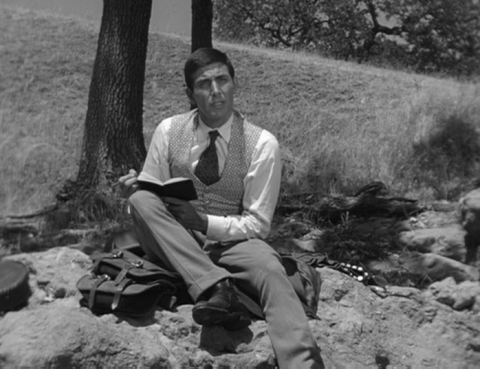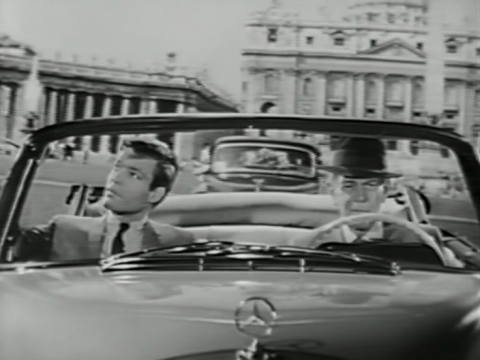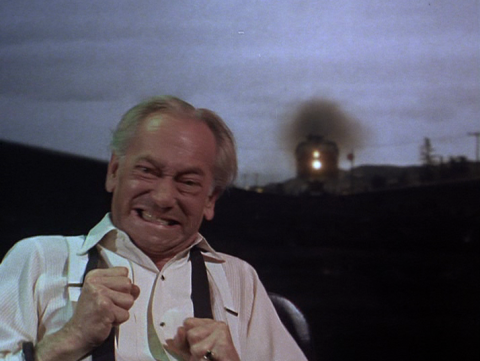Obituary: Christopher Knopf (1927-2019)
February 27, 2019
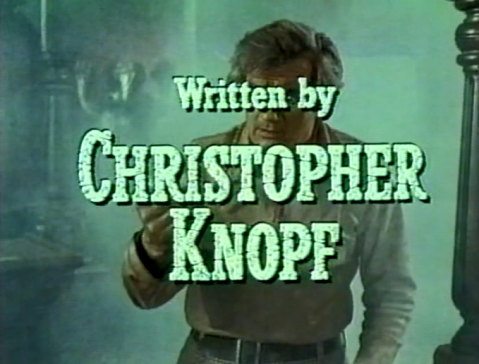
When Christopher Knopf, who died on February 13 at the age of 91, turns up in the history books, it is usually a source rather than as a subject.
During a stint as a contract writer at ex-movie star Dick Powell’s significant and, today, too little-known Four Star Productions, Knopf (the k is pronounced, the f is silent) befriended with a trio of future television superstars: Sam Peckinpah, Bruce Geller, and Gene Roddenberry. He saw the truculence that would expand into full-blown insanity and addiction once Peckinpah became a prominent film director, and he watched from the sidelines as Geller and Roddenberry gave birth, respectively, to Mission: Impossible and Star Trek. Roddenberry kidnapped him once on his motorcycle, and took Knopf on a rain-slicked ride that ended with a crash, torn clothing, scraped skin. “Do you realize you may never do that again?” Roddenberry asked his dazed companion. A self-effacing family man, Knopf had little in common with these larger-than-life characters, but remained a bemused, lifelong observer of their perpetual midlife crises.
And yet Knopf’s own accomplishments, despite his reticence to claim credit for them, were prodigious. A past president of the Writers Guild of America (from 1965 to 1967), an Emmy nominee, and a winner of the coveted Writers Guild Award, Knopf was a writer of considerable skill. His voice, though distinctive, echoed off those of the other talented men he shared ideas with in his formative years. His best work espouses the compassionate liberalism one associates with Roddenberry, as well as the pessimistic, myth-busting sobriety of Peckinpah. Knopf wrote about himself a great deal, although his touch was delicate enough that the elements of autobiography might remain safely hidden without the road map Knopf provides in his engaging 2010 memoir, Will the Real Me Please Stand Up.
Sensitive about his origins as a child of privilege (and a beneficiary of Hollywood nepotism), Knopf penciled himself into most of his early scripts as a grotesque but ultimately sympathetic outsider. His first television western, “Cheyenne Express” (for The Restless Gun), centers around a weasel (Royal Dano) who back-shoots the boss of his outlaw gang and then expects the show’s hero (John Payne) to protect him from retribution. Dano’s character would be utterly despicable, except that Knopf gives him a sole redeeming quality, a devotion to feeding a stray dog that tags along behind him – Umberto D in the Old West. A traditional narrative until the final seconds, “Cheyenne Express” ends with a curious anti-climax – Dano falls out the back door of a train as the gunmen close in on him – that scans like a stranger-than-fiction historical anecdote, or a proto-Peckinpavian grace note.
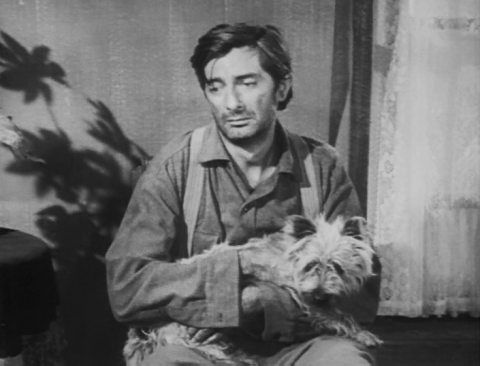
Inscribing his characters with a hidden personal or political meaning became Knopf’s trick for giving early westerns and crime stories a potency often missing from other episodes of the same series. A feminist streak comes through in twinned half-hours that fashioned tough, doomed distaff versions of his autobiographical loner figure. “Heller” (for The Rifleman) and the misnamed “Ben White” (for The Rebel, with an imposing Mary Murphy as a sexy outlaw’s girl known only as T) told the stories of backwoods women – defiant, independent, but with no recourse other than self-immolating violence to combat the drunken stepfathers, Indian captors, and psychotic lovers who victimize them. “Heritage,” a Zane Grey Theater, cast Edward G. Robinson as a farmer whose neutrality during the Civil War may extend as far as turning his Confederate soldier son over to Union occupiers. “That man was my father, who I felt at the time cared more about his work than about his kids,” Knopf told me. Yet the father in “Heritage” finally redeems himself, choosing his son’s life over the barn and the crops that will be burned as punishment for his collaboration.
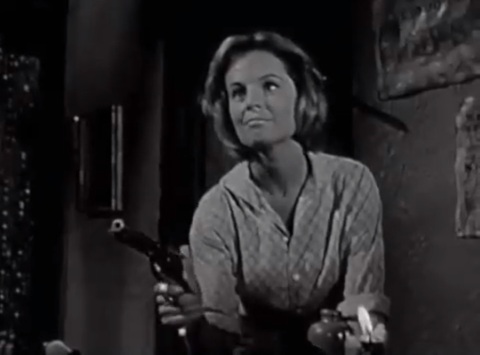
Widening his gaze from psychological to social injustices, Knopf sketched Eisenhower as an ineffectual sheriff on Wanted Dead or Alive and contributed a fine piece of muckraking to Target: The Corrupters. An exposé of migrant labor abuse, “Journey Into Mourning” centers around a cold-eyed portrait of a cruel and eventually homicidal foreman named Claude Ivy (Keenan Wynn). Ivy’s villainy is flamboyant and inarguable but Knopf insists upon context. Ivy presents himself as a self-made success, a former worker who grants himself the right to mistreat his workers because he clawed his way out of the same misery. Even as the laborers beg and threaten for a few cents more, Ivy grubs for his own meager share, dickering with a slightly more polished but equally callous landowner (Parley Baer). Knopf’s malevolent exploiter is just the middle man; the true evil, though name is never put to it, is capitalism. As in “Heritage,” Knopf is passionate without becoming polemic, studying all sides of a dilemma with an even gaze.
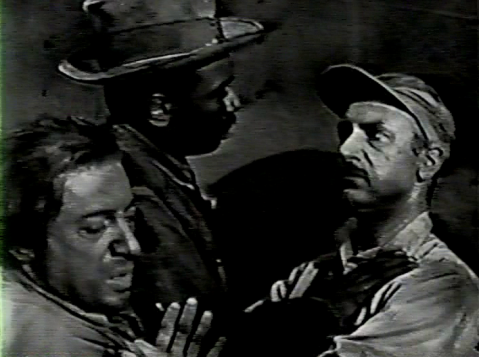
At the age of thirty, Knopf netted an Emmy nomination for “Loudmouth,” an Alcoa Theatre tour-de-force written especially for Jack Lemmon. His reward, of sorts, was an exclusive contract with Four Star, the independent company that produced Alcoa (and Zane Grey Theater). It was a mixed blessing. Knopf loved working for Dick Powell and recognized that Four Star offered writers an unusual creative latitude. However, he found that he could not protect his interests as effectively as Geller, Peckinpah, or Richard Alan Simmons, Four Star’s other star scribes. Unable to unencumber himself from Powell’s credit-grabbing lackey, Aaron Spelling, Knopf spent much of his time at Four Star toiling on pilot development and other impersonal assignments.
Four Star ended badly for everyone, starting with Powell, who died in early 1963 after a brief bout with cancer. The company collapsed and Knopf made a damaging horse-trade to escape the rubble, giving up credit and financial interest in a western he co-created, The Big Valley. Knopf, in the days following John F. Kennedy’s assassination, had written a pitch called The Cannons of San Francisco, which imagined a West Coast version of the Kennedy family that would reign over Gold Rush-era California. Powell’s successor, Tom McDermott, favored a vaguely similar ranching dynasty premise from A. I. Bezzerides that already had a network commitment, and pressured Knopf into writing the first two episodes in exchange for a release from his Four Star contract. Knopf merged his own characters into Bezzerides’s setting, and the result was The Big Valley. The “created by” credit on which ended up going to Bezzerides and producer Louis F. Edelman, who brought star Barbara Stanwyck into the show. (Bezzerides exited the show more colorfully than Knopf, in a bout of fisticuffs.)
Knopf’s two-part Big Valley pilot script forayed once again into Oedipal anxiety, contrasting the manor-born assumptions of a rancher’s legitimate sons (Richard Long and Peter Breck) with the resentment of their bastard brother (Lee Majors). Left in Knopf’s care, The Big Valley might have become an epic family serial – a novel precursor to Dallas – rather than the traditional western that lingered on ABC for four seasons as a middling epitaph for Four Star.

But letting go of the Barkley clan proved liberating for Knopf, who moved on quickly to write a pair of exceptional Dr. Kildares. “Man Is a Rock,” probably his finest episodic work, takes a hard-drinking, hard-charging salesman who resides somewhere on the Glengarry Glen Ross / Mad Men axis, and fells him with a coronary event that requires not just surgery but a lengthy recuperation. Knopf’s interest is in the difficulty of accepting illness as a life-altering event, and the idea that a man might allow himself to die simply because a change in routine represents a more tangible threat. As Franklin Gaer, the salesman who tries to make a deal with death, Walter Matthau contributes an astoundingly visceral performance, full of pain and fear – a feat all the more terrifying when one realizes that Matthau was himself only a year away from a near-fatal heart attack that would shut down production of Billy Wilder’s The Fortune Cookie for months.
Although cinephilia was not a key motif in Knopf’s work, it does play a role in both of his Dr. Kildares. The second is set within the film industry, and although “Man Is a Rock” is not, it climaxes with a scene in which Franklin Gaer delivers this drunken, despairing monologue to his frightened teenage son:
There was this picture, see, and it had this trapeze artist in it. He wasn’t a Jew or anything, but he was in this concentration camp, and he and a bunch of the others broke out, including Spencer Tracy. Anyway, the Germans get to cornering this guy, this trapeze artist, up on some roof in the middle of a German town somewhere. There he is up there, and down below are a bunch of people. They’re screaming at him to jump. And scrambling over the rooftops you’ve got all the nazis with the machine guns and everything, and they’re getting to him. Well, there’s no way out. It’s either back to prison, or jump. So, that’s what he does. He throws his arms out like that, and he shoves off in the prettiest ol’ little swan dive you ever saw in your life. One hundred feet smack right down into the pavement. You know what they did in that theater? Everybody stood up and applauded. For over a minute!
The speech is not only an unusually abstract metaphor for Gaer’s dilemma, but also another coded autobiographical reference. Although Knopf doesn’t name the film in his script, Gaer is describing a moment from The Seventh Cross, a 1944 MGM production overseen by his father, Edwin H. Knopf.
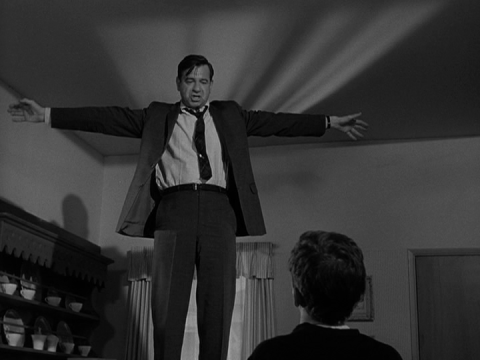
In 1967, Knopf got another western pilot on the air, and this time stayed with the project to oversee its creative development. Set in 1888, Cimarron Strip was less a western than an end-of-the-western, a weekly ninety-minute elegy for the frontier that bore the unmistakable influence of the work Knopf’s friend Sam Peckinpah had been doing at Four Star. Of the series’ twenty-three episodes, at least half a dozen centered on some larger-than-life tamer of the wilderness who was now obsolete and who would, by the story’s end, be stamped violently out of existence by encroaching civilization. Knopf’s pilot script, “The Battleground,” charted the inevitable showdown between an irredeemably savage outlaw (Telly Savalas) and his former compatriot, Jim Crown (Stuart Whitman), who is now the marshal of the Cimarron Territory and the series’ protagonist. Preston Wood’s mournful “The Last Wolf” took a sociological perspective in its examination of the wolvers, a class of rambunctious hunters whose value to the community had plummeted once they hunted the prairie wolf into extinction. William Wood’s “The Roarer” guest starred Richard Boone as a cavalry lifer so conditioned to bloodshed that, as a garrison soldier, he creates violence in a time of peace. Explicitly revisionist, Harold Swanton’s “Broken Wing” and Jack Curtis’s extraordinary “The Battle of Bloody Stones” depicted thinly-disguised versions of (respectively) Wyatt Earp and Buffalo Bill as dangerous charlatans interested in only in their own mythmaking.
Network executives were perplexed by Knopf’s unorthodox approach to the conventions of the western genre, which often meant nudging Cimarron Strip into areas of allegory (several episodes had anti-war, which is to say anti-Vietnam, undertones) or toward other genres altogether. Two particularly strong segments productively hybridized the western and the horror story. “The Beast That Walks Like a Man,” with a teleplay by Stephen Kandel and Richard Fielder, puts Marshal Crown on the trail of a possibly otherworldly prairie predator that mutilates its victims in a manner unlike any known man or beast. Some scenes, such as the one in which a hardened pioneer patriarch (Leslie Nielsen) finds his family mutilated, are terrifying, and the unexpected resolution is neither outlandish nor a cop-out. Even better is Harlan Ellison’s forgotten classic “Knife in the Darkness,” which makes the bold conceptual leap of transporting Jack the Ripper into the Old West.
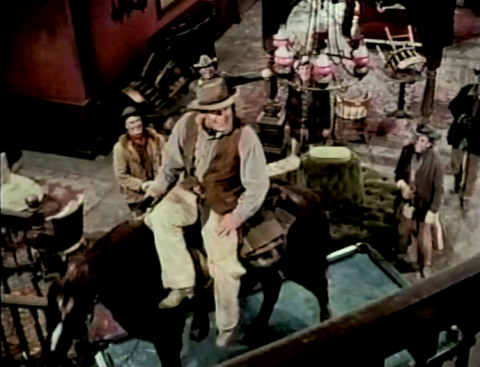
It would be gratifying to hold up Cimarron Strip as an overlooked masterpiece that anticipated the magnificent spate of postmodern westerns that filmmakers like Peckinpah, Robert Altman, Arthur Penn, and others would make a few years hence. Unfortunately, only a handful of the show’s finished segments achieved as much stature as the daring, offbeat synopses that Knopf detailed in our interview would suggest. The rest became casualties of an aggressive campaign of sabotage by CBS, even after Knopf and his staff pursued a preemptive strategy of appeasement by alternating straightforward action stories with more challenging high concept narratives.
Cimarron Strip was Knopf’s final foray into episodic television for more than twenty years. One of the few rank-and-file episodic writers who transitioned wholly into longform work, Knopf crafted a number of distinguished features and television films, including the cult item A Cold Night’s Death, a two-hander about scientists (Eli Wallach and Robert Culp) cracking up in Arctic isolation. For the big screen, Knopf wrote one terrific period piece, the Depression-era rail-riding epic Emperor of the North, and two-thirds of another, the western Posse. In both cases, the subtleties of his characters and ideas were coarsened by the films’ directors (Robert Aldrich and Kirk Douglas, respectively), and yet Knopf’s innate intelligence and empathy remain in evidence in the films. He returned to television at the end of his career, co-creating and producing the Steven Bochco-esque legal drama Equal Justice in 1990.
This piece was adapted from the introduction to my 2003-2004 interview with Christopher Knopf, which will be a chapter in a forthcoming book.
Late Innings
September 7, 2010
John Ford directed a handful of television shows, but the most Fordian television episode I’ve ever seen is “A Head of Hair,” a Have Gun Will Travel from 1960.
Scripted by the unsung master Harry Julian Fink, “A Head of Hair” sends Paladin deep into Indian country to find a long-ago kidnapped white woman, who may or may not have been spotted from a distance by a cavalry officer (George Kennedy). The girl is blonde, but we’ll learn that hers is not the head of hair to which the title refers. As a guide, Paladin recruits a white man who used to live as a Sioux, but who is now a destitute alcoholic. The first sparse exchange between them lays out the impossibility of the mission and establishes BJ’s quiet self-contempt:
PALADIN: Would a couple of men have any chance at all?
ANDERSON: Men? A couple of Oglala Sioux, maybe. Maybe even me, seven, eight years ago. But you? They’d stake you out between two poles and flay you alive.
But Anderson takes the job because he needs drinking money. The series of tense confrontations with the Nez Perce through which he and Paladin then navigate are not standard cowboys-versus-Indians stuff. They are precise, specific rituals of masculine and tribal pride, none of which take a predictable shape. Because Paladin is a novice among the Nez Perce and Anderson is an expert, Fink has a clever device by which to clue the audience in on what’s at stake in each conflict. Gradually, these question-and-answer sessions also disclose a profound philosophical schism between the two men. Paladin is preoccupied with personal honor and ethics, while Anderson is consumed with a self-abasing nihilism. Both are deadly pragmatists, but only one of them will take the scalps of dead braves.
The Nez Perce mission concludes in victory, but it comes with a price. Success turns the two trackers against one another, for reasons that Paladin cannot understand until after violence erupts between them. “Why? Why?” are Paladin’s last words to Anderson in “A Head of Hair,” and only the answer is the unsatisfactory moral of the story of the scorpion and the frog: because it was in his nature.
Maybe it’s a coincidence that “A Head of Hair” falls chronologically between the two John Ford westerns that depict a two-man journey into the wilderness in search of a missing white woman (or women) in the custody of Indians. Both of the films imagine such captivity as a kind of unspeakable horror. “A Head of Hair” doesn’t dwell on that aspect of the story, but it does glance at the repatriated Mary Grange (Donna Brooks) long enough to construe her as lost, maybe for good, in the breach between two cultures. Another spare Fink line: “I would have gone with him,” Mary says, looking sadly after a departing Anderson. “They say the Sioux are kind to their women.”
I haven’t yet identified the actor who plays Anderson because that’s the blinking neon sign that points to Ford. It is Ben Johnson, the ex-stuntman who was an important member of Ford’s “repertory company” during the late forties and early fifties. Johnson delivers what may be his finest performance prior to the Oscar-winning turn in The Last Picture Show: understated, unadorned, just barely hinting at a deep well of sadness and self-loathing. Imagine that line – “maybe even me, seven, eight years ago” – in Johnson’s voice and then picture the flicker of a weary smile that goes with it.
There’s another Ford fellow-traveler in the mix here, too: the director, Andrew V. McLaglen, was the son of Victor McLaglen, who won an Oscar for The Informer and overlapped with Ben Johnson in two of the Cavalry Trilogy films. McLaglen didn’t have Ford’s eye but he did get to shoot “A Head of Hair” on location (in Lone Pine?), and frame his actors against the landscape in a way that reminds us the wilderness is part of the story. The precision in McLaglen’s compositions match the precision in Fink’s scenario; when those three braves whose scalps are about to be up for grabs turn their backs on Paladin, there’s room to believe that maybe gunplay really has been avoided. All that’s left is something to give “A Head of Hair” some size, and that comes via Jerry Goldsmith’s sweeping brass- and woodwind-driven score. It was one of only two that Goldsmith wrote for Have Gun Will Travel.
“A Head of Hair” falls within a string of amazingly strong segments that opened Have Gun’s fourth season. There’s another Fink masterpiece, “The Shooting of Jessie May,” a four-character confrontation that ends in a really shocking explosion of violence; “Saturday Night,” a jail-cell locked-room mystery with a dark underbelly; “The Poker Fiend,” a study of degenerate gambling with an existential component and a mesmerizing, atypically internal performance from Peter Falk; and “The Calf,” a cutting allegory about a man (Denver Pyle, also a revelation) obsessed with the wire fence that marks his territory. Lighter entries like the baseball comedy “Out at the Old Ballpark” and “The Tender Gun,” with Jeanette Nolan as a crotchety female marshal under siege (Nolan, like Walter Brennan, had a with-teeth and a without-teeth performance; guess which one this is), are not as strong but they do demonstrate the impressive tonal range of Have Gun. One measure of a great television series – one which The X-Files taught me – is the extent to which it can avoid being the same show each week while still remaining, on a fundamental level, the same show each week.
*
The source of the fourth-season shot in Have Gun’s arm? A new producer and story editor, Frank Pierson and Albert Ruben, took over, and it’s not a coincidence that both were superb writers. By that time, the star of the series, Richard Boone, had seized control of it in a way that would soon be common for TV stars but that was unprecedented in 1960.
Boone got to direct a lot of episodes but, more importantly, he had approval over the story content and the behind-the-camera personnel. A snob who thought he should be doing serious acting, not westerns, Boone set out to make Have Gun as un-western a western as possible. That’s probably how Pierson and Ruben got their jobs: Boone wanted bosses (or “bosses”) who would be down with phasing out the cowboy schtick in favor of broad comedies, existential tragedies, pastiches of Verne and Shakespeare, and so on. Of course, Pierson and Ruben fell out of favor with Boone and he kicked them to the curb after a year or so . . . but that’s a story for another day.
Regime change and star ego-trips also characterized Wanted: Dead or Alive in its third and final season. Steve McQueen had always been the whole show, but by 1959, everybody knew he was destined for major stardom, including McQueen himself, who seemed to be using the final run of episodes as a laboratory in which to determine exactly which tics and slouches to incorporate into his definitive screen persona. Wanted: Dead or Alive also got a new producer for its home stretch, a man named Ed Adamson. Supposedly McQueen drove him crazy. Adamson was a prolific writer and, either to save money or time or just because McQueen was all the hassle he could take, he took the unusual step of divvying up all twenty-six of that year’s script assignments between himself and one other writer, Norman Katkov.
Katkov was one of my first oral history subjects. Since I published that piece, I’ve used this blog to weigh in on some of Katkov’s work that I hadn’t seen at the time of our interview. The most important of the shows that were unavailable to me then was Wanted: Dead or Alive. Katkov’s fourteen episodes represent his only sustained work on a series other than Ben Casey, and so I am a little disappointed not to be able to call them another set of overlooked gems. In most cases, without consulting the credits, I’d have a hard time telling which episodes are Katkov’s and which were written by Adamson, a straight-arrow action and mystery man.
Katkov managed a couple of idiosyncratic scripts, like “The Twain Shall Meet,” in which Josh Randall teams up with a fancy easterner named Arthur Pierce Madison (Michael Lipton). Madison is a journalist, which allows Katkov (a former beat reporter) to get in some knowing gags. Contrary to the usual genre expectation of the western hero’s stoic modesty, Josh is intrigued, even flattered, at the prospect of having his exploits recorded for posterity. Mary Tyler Moore has an amusing bit as a saloon girl who’s even more dazzled by the prospect of fame. Katkov focuses on the differences in how Josh and Madison make their respective livings: the contrast between physical and intellectual (and, amusingly, steady versus freelance work). In a quiet moment, Madison asks, “Is it all you want?” Josh replies, “Almost.” Westerns did not thrive on introspection, so it’s a shock to see a show like Wanted: Dead or Alive take a pause to contemplate whether its hero is happy in his work.
*
Does it seem as if this space circles back sooner or later to a small group of very good writers? I would argue that the history of television circles that way, too. Anthony Lawrence: another oral history subject on whom I’ve followed up here, first on The Outcasts and now on Hawaii Five-O. Lawrence logged one episode each in the third and fourth season, and the trademarks I described out in my profile are evident in both. There are the show-offy literary allusions: “Two Doves and Mr. Heron” ends with a quote from the Buddha. There is the interest in topical issues, which began on Five-O with the germ-warfare classic “Three Dead Cows at Makapuu” (germ warfare). Lawrence followed that up with scripts on homosexuality (Vic Morrow, fruity in more ways than one, as a whack-job who fondles John Ritter in “Two Doves”) and Vietnam (“To Kill or Be Killed”).
There is also what may be Lawrence’s defining trait as a writer: the unpredictable burst of emotional intensity within otherwise routine material. “To Kill or Be Killed” reminded me of how puzzled I was that the same Outer Limits writer could have come up with both the heart-rending “The Man Who Was Never Born” and the diffident, heavy-handed “The Children of Spider County.” In “To Kill or Be Killed,” Lawrence caps three hit-or-miss acts of family melodrama (dove son vs. hawk father) with a long, exhausting monologue – a tape-recorded suicide note that plays over horrified reaction shots of the other characters. It might seem like lazy writing, and maybe it was, to withhold all the emotion from a script and then dump it into the final minutes. But I think Lawrence was crazy like a fox. That monologue concerns My Lai (under a different name), something a lot of people watching Hawaii Five-O probably didn’t want to hear about, and with his crude structural tactic Lawrence drops the topic in their laps like a turd on the dinner table.
Hawaii Five-O, in its fourth year, is almost exactly the same show as it was in its first. It’s still a show that allows for a lot of variety in its formula – or rather, the alternation between six or eight different formulas. Unlike on Wanted: Dead or Alive, one can detect an individual authorial touch in many of the episodes. The lurid pulp shocker “Beautiful Screamer” is pure Stephen Kandel. The dullest espionage outings and the most heavy-handed McGarrett lectures usually trace back to the team of Jerry Ludwig and Eric Bercovici, who, unfortunately, wrote quite a few of each.
One of the most popular Five-Os, “Over Fifty? Steal,” falls into this stretch of the series. It was penned by a writer new to the show, E. Arthur Kean. It’s a semi-comedy in the cuddly-oldster-as-criminal-mastermind genre, featuring a smug Hume Cronyn as a serial robber who goes out of his way to taunt McGarrett and crew. I like “Over Fifty,” but Kean’s second script for the series deserves more attention. More diamond-hard than heart-shaped, “Ten Thousand Diamonds and a Heart” is another caper, but played deadly straight this time. It starts with a parking garage prison bust and turns into a jewel heist, which Kean sets up as a battle of wits between another master criminal (Tim O’Connor) and an impregnable high-rise. Kean fusses over the details: scale models, elevator schematics, medication for a bum ticker. Somehow, he makes the minutiae fascinating. They’re the diamonds, and the heart is the clash between O’Connor and the “banker” (the guy who’s funding the heist) played by Paul Stewart. It’s a portrait of two paranoid career criminals who can’t trust anyone but themselves, gnashing at each other until they tear their own caper apart.
I had seen a few of Kean’s earlier scripts, for The Fugitive and The F.B.I., without having much of a reaction. But the Hawaii Five-Os that mark him down as, in the Sarrisian lexicon, a Subject For Further Research.
*
Also this year I’ve watched most of the fourth and penultimate season of NBC’s Dr. Kildare, a once near-great doctor drama that slowly turned mushy and bland. Further research department: one of those turkeys marked the prime-time debut, as far as I can tell, of one E. Arthur Kean.
A few fourth-year episodes written by series veterans like Jerry McNeely and Archie L. Tegland still felt the old Dr. Kildare: tough, smart, sagacious. Tegland’s “A Reverence For Life” trots out one of the standbys of the medical drama, a story of a patient who refuses life-saving treatment due to her religious convictions. My own inclinations always favor science over superstition; but Dennis Weaver, with his innate humility, is so perfect as the Jehovah’s Witness whose wife is dying that I was rooting for him to prevail in his faith.
I am also partial to Christopher Knopf’s “Man Is a Rock,” a terrifying study of a heart attack victim (Walter Matthau) forced to confront his own mortality, and “Maybe Love Will Save My Apartment House,” a zany romp by Boris Sobelman, who wrote a handful of very funny black comedies for Thriller and The Alfred Hitchcock Hour. But Kildare’s fourth year includes duds from other good writers, like Adrian Spies (Saints and Sinners) and Jack Curtis (Ben Casey), and that’s often a sign of tinkering from upstairs.
By 1964 Richard Chamberlain was one of TV’s hottest stars, a heartthrob with a viable recording career. MGM (which produced Dr. Kildare) had cashed in on his popularity by building three medium-budget feature films around him in three years. Both the studio and the network had a big investment in Chamberlain, and I’m guessing that executive producer Norman Felton may have capitulated to pressure to give viewers a maximum dose of Chamberlain romancing and singing. I’m not kidding about the singing: “Music Hath Charms” is a plotless let’s-put-on-a-show show about an amateur night for the hospital staff. I can’t decide which episode is the series’ nadir: “A Journey to Sunrise,” a vanity piece that gives Raymond Massey (who co-starred as Kildare’s windbag boss Dr. Gillespie) a dual role as a dying Hemingway-esque writer, or “Rome Will Never Leave You,” a prophetically titled, turtle-paced three-parter that contrives gooey romances for both Kildare and Gillespie during an Italian business trip.
I’ve proposed corporate greed as the major cause for the de-fanging of the once sharp Dr. Kildare, but there’s also the David Victor factor. In the years before signing on as Norman Felton’s right-hand man, Victor was a hack genre writer (with a partner, Herbert Little, Jr., who disappeared after Victor hit the big time). In the years after he and Felton parted ways, Victor copied the Kildare format and quickly ran it into comfortable mediocrity as the head man on Marcus Welby. Was Victor the source of the blandness that set in on Kildare as the show’s exec, Norman Felton (by all accounts a discerning producer), turned his attention to developing The Lieutenant and The Man From U.N.C.L.E. Maybe he was just in the wrong place at the wrong time – but if so, Victor was in an even wronger place at an even wronger time a year later, when he moved over to The Man From U.N.C.L.E. as the supervising producer who supervised that show’s second- and third-season slide into cringeworthy camp.
*
The Man From U.N.C.L.E.: When we last checked in on TV’s favorite spies, we found a mortified Robert Vaughn frugging with a man in a gorilla suit. I had hoped to follow that cheap shot with a report on how The Man From U.N.C.L.E. rebounded in its final half-season, as new producer Anthony Spinner followed the network’s oops-we-fucked-up orders to take out the yuks and put back the action. I’d heard that the fourth season was “too grim,” but hey, I like grim. Especially if it’s the alternative to Solo and Kuryakin partying with Sonny and Cher or riding on stinkbombs (funny for Kubrick, not for Kuryakin). Grim is good.
Didn’t work out that way. The fourth season isn’t grim, it’s dull. The plots are perfunctory, the characters cardboard, the casting uninspired. The books say that Spinner tried to bring U.N.C.L.E. back to its roots, but the shows play like nobody much cared what went on the screen. I gave up when I got to “The THRUSH Roulette Affair,” which rien ne va pluses with one of the laziest deus ex machinas I’ve ever seen. See, THRUSH baddie is torturing some guy with a machine that figures out the victim’s worst fear and then gets him to talk in a room full of (not at all scary) footage of said fear. In this case, the poor sucker is more afraid of being run over by a train. Wouldn’t you know it, when the shit hits the fan, the evil scientist bursts out with a clumsy load of exposition: turns out he tested the machine on the main THRUSH baddie (Michael Rennie), and his greatest fear is exactly the same as the other guy’s. Two trainophobes in a row! Which means that when the U.N.C.L.E. guys shove Rennie into the scaring-to-death machine, all of that (not at all scary) train stock footage is already cued up!
Usually I don’t even notice plot holes but, seriously, this one’s just insulting. How could Spinner or the writer (Arthur Weingarten) or the story editor (Irv Pearlberg) not come up with anything better than that? Especially since they swiped the idea from 1984 in the first place?
Another of the fourth season U.N.C.L.E.s spieled some boring Latin American palace intrigue (featuring not-at-all-Latin American Madlyn Rhue), which got me to thinking. The Lieutenant ended by sending its stateside serviceman hero off to die in Vietnam. U.N.C.L.E. should’ve gone out the same way, with Solo and Kuryakin headed off to Chile to assassinate Salvador Allende. That would’ve been my kind of grim.
Obituary: Nina Laemmle (1910-2008)
November 6, 2008
Veteran television writer and story editor Nina Laemmle died on August 12 at the age of 97.
Laemmle held long-running positions as the story editor of several top television shows during the sixties and seventies. From 1964-1969, Laemmle was the story editor of Peyton Place, and one of the three writers who mapped out the prime-time serial’s complex plotlines (the others were Del Reisman and, for a time, Richard DeRoy). From there, Laemmle moved over to Marcus Welby, M.D., where she was the medical drama’s “executive story consultant” during its first five seasons. Following that, she worked on Quinn Martin’s short-lived Tales of the Unexpected (1977) and became a controversial headwriter of the daytime soap Days of Our Lives in the early eighties.
Prior to her stints on those series, Laemmle had worked in the story department at Four Star, Dick Powell’s busy television production company, from about 1958 until 1963. In that capacity she was credited as the story editor on much of Four Star’s output, including Richard Diamond Private Detective, The Zane Grey Theatre, Target: The Corrupters, and The Lloyd Bridges Show.
Most television story editors were freelance writers who took staff jobs occasionally. Laemmle was one of a handful of story gurus who functioned more like a book editor, forging supportive relationships with writers and working with them to develop their material during long, collegial conferences in her office. On Peyton Place, the show’s youthful writing staff was divided on the value of Laemmle’s motherly but rigorous story meetings: some found it stimulating, others stifling.
Laemmle sponsored the careers of dozens of talented young writers. When I spoke to her very briefly in 2005, Laemmle seemed especially proud of having given Robert Towne (Chinatown, Shampoo) one of his first assignments, on The Lloyd Bridges Show.
Laemmle was born in England on November 20, 1910, with the memorable maiden name of Nina Dainty. Later, in Hollywood, Nina married Ernst Laemmle, a producer and the nephew of Universal Pictures mogul Carl Laemmle. When Ernst Laemmle died in 1950, Nina took a job as a secretary in the film industry to support her three children.
Nina Laemmle’s colleagues described her in terms that evoked the stereotype of the genteel English lady: classy, reserved, private.
Christopher Knopf, past president of the Writers Guild of America and a talented Four Star contract writer during the early sixties, established himself at the studio after Laemmle invited him to write for The Detectives. In 2003, Knopf described for me the atmosphere that Laemmle helped to create at Four Star:
Nina was very, very creative and helpful with the writers. She loved the writers. You could go in and talk story with Nina. You could say, “I’ve got a problem with this script.” She’d say, “Come on, let’s have lunch.”
Being under contract, you went either to a producer – they usually came to you – or you went to Dick [Powell]. Or you went to Nina first and said, “What about this idea?”
You could work on anything. You’d do pilots. They were given to you sometimes, or you created them yourself. Maybe Nina would call you, or you’d go up to Dick or Nina. Everybody knew everybody. It was just wide open. There were no cliques out there.
Del Reisman, another former WGA president and Laemmle’s colleague on Peyton Place, issued this statement yesterday:
Stories were her passion. All manner of stories. Stories from celebrated literature. Stories from the headlines. Stories from her own considerable life’s experience. She applied this passion to whatever project she worked on, from the highly theatrical Peyton Place, serialized for years, to the clean, clear narratives of Marcus Welby, M.D., semi-anthological, a new story each episode. In the most professional sense, she was obsessed, and offered one hundred percent of her restless mind to all who worked with her and for her.

